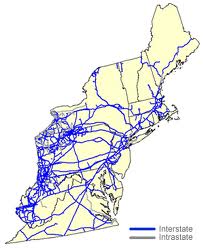“Iso New England” has recently published a draft report raising the specter of a period of severe winter weather without electricity in New England. The gas supply pipelines may soon lack capacity to carry enough energy to heat homes and generate electricity. This is unlikely at present, but possible changes could allow it to happen, the report suggests.
In New England, natural gas to generate electricity is a relatively new thing, rising from 5% in 1990 to 51% in 2011. A continuing increase in the share of gas may occur. At the same time, there is a dramatic shift from heating oil to gas for heating homes and businesses. Transmission capacity is fixed, so a sudden increase in use, caused by an extended cold snap, could produce a demand that could not be supplied, causing a condition that could be met only by reducing electrical production.
The older fuels, coal and oil for electricity, and heating oil for homes were both largely stockpiled before the beginning of the winter. Gas storage areas are remote and a on a local basis gas must be supplied by on demand flow. Additional problems recognized in the report which result in sufficient supply are “other stressed conditions” and some kind of failure of the transportation system for gas.
Another problem is that gas must be contracted for in advance of delivery. Gas users can not withdraw more than the contracted amount. Gas suppliers expect a uniform around-the-clock flow, but electrical generators have a daily peak in the afternoon. In some cases gas is burned in the afternoon hours only.
One solution which suggests itself is one or more additional large diameter pipelines from the western areas which can store year-round production for winter supply. Additionally, incentives for electrical generators to maintain stockpile-able fuel generating capacity and stockpiled fuel are seen as a possibility.
Iso New England is an organization independent of the corporations that generate electricity, but which has responsibility for controlling production, transmission and pricing of electricity in the New England states and beyond. The draft of the paper, Addressing Gas Dependence, was released this past July.


{ 2 comments… read them below or add one }
As England is looking to produce electricity from the natural gas, so they will be needing lots of natural gas in this winter for residential heating. How they choose to use the resources will matter a lot, showing the need for a comprehensive overall energy plan.
Gas Free Seneca was formed in early 2011 in response to Inergy, LP’s plan to “build an integrated gas storage and transportation hub in the Northeast,” according to its press announcement, at the U.S. Salt plant just North of Watkins Glen, NY. Gas Free Seneca started out as a small group of concerned citizens trying to spread the word about the proposed LPG storage facility. Since its inception, Gas Free Seneca has grown into a coalition of many concerned citizens, local business owners and regional environmental groups. It is the aim of Gas Free Seneca to protect Seneca Lake, its environs and local home-grown businesses from the threat of massive industrialization.
See also: http://www.EcoWatch.org